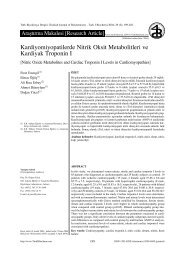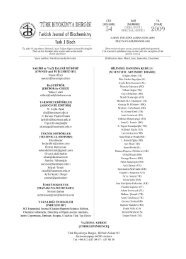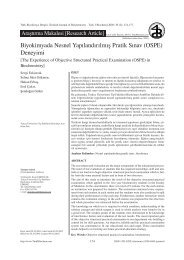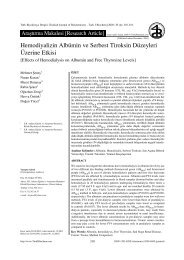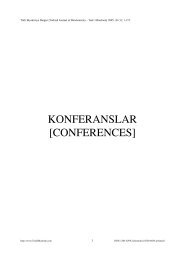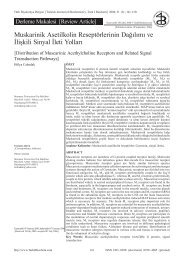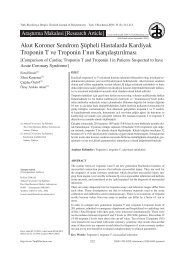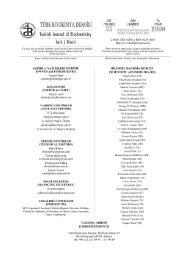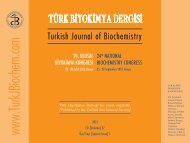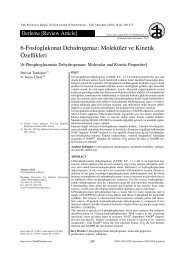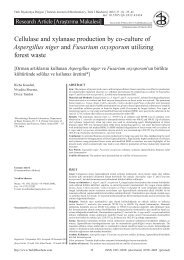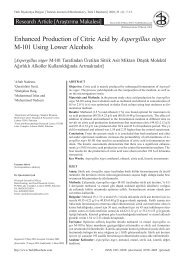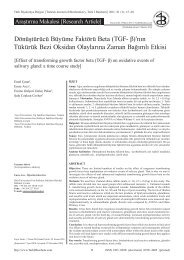23. Ulusal Biyokimya Kongresi Ãzel Sayısı - Türk Biyokimya Dergisi
23. Ulusal Biyokimya Kongresi Ãzel Sayısı - Türk Biyokimya Dergisi
23. Ulusal Biyokimya Kongresi Ãzel Sayısı - Türk Biyokimya Dergisi
Create successful ePaper yourself
Turn your PDF publications into a flip-book with our unique Google optimized e-Paper software.
XXIII. ULUSAL B‹YOK‹MYA KONGRES‹<br />
29 Kasım - 2 Aralık 2011<br />
Hilton Hotel - Adana<br />
<strong>23.</strong> <strong>Ulusal</strong> <strong>Biyokimya</strong> <strong>Kongresi</strong>, Adana [23 rd National Biochemistry Congress, Adana / TURKEY]<br />
İÇİNDEKİLER<br />
DAVETLİ KONUŞMACI ÖZETLERİ<br />
BELLEK OLUŞUMU VE BİLGİ EDİNİMİ<br />
Ali DEMİRSOY<br />
Hacettepe Üniversitesi, Fen Fakültesi, Biyoloji Bölümü, Ankara / Türkiye<br />
I. BÖLÜM: ÇEŞİTLENMENİN ALT YAPISI<br />
BİYOMERLER – REKOMBİNASYON: Her şey DNA ile başlıyor: Bilindiği<br />
gibi canlıların tümünün yapı ve davranışını olduğu gibi, insanların da hem duyu ve<br />
düşünce dünyaları hem de yapısal özellikleri, genler dediğimiz, ham maddesi dünyada<br />
mevcut atomlardan oluşmuş, canlılara göre dizilimi farklılık gösteren DNA molekülü<br />
tarafından saptanır.<br />
II. .BÖLÜM: BELLEĞİ OLUŞTURAN UNSURLAR: BEYNİN YAPISAL VE<br />
İŞLEVSEL OLARAK EVRİMİ<br />
•. Birincisi, belleği (bununla ilişkin olarak beynin) yapısal olarak evrimine, bugüne<br />
kadar yapılmış olan biyolojik gözlem ve bulgularla bir açıklama getirmek.<br />
• .İkincisi ise, belleğe, bilginin yerleştirilmesi, beyin sığasının geliştirilmesi ile ilgili<br />
bazı yaklaşımları olabildiğince açıklamaktır.<br />
BELLEĞİN OLUŞUM EVRELERİ<br />
Evrimsel olarak evrenin ve biz insanların şu ana kadar geçirmiş olduğu süreçte,<br />
merkeze insanı koyarak, bir biyolog gözüyle, merkezi sinir sisteminin oluşumunu dört<br />
evreye ayırabiliriz.<br />
• İnorganik evrim.<br />
• Biyomoleküllerin evrim<br />
• Hücre Organizasyonu.<br />
• Bellek<br />
BELLEKSİZ CANLILARDAN BELLEKLİ CANLILARA GEÇİŞ<br />
Amphioxus’da beyin: Omurgalıların atası, solucanlarla omurgalılar arasındaki<br />
bir hayvan grubunda aynı şekilde küçük bir beyin oluşumunu, arkaya uzanan sinir<br />
usantılarını ve omurgalılara özgü notokordu görmek mümkündür. Daha sonra ilkel<br />
balıklardan memelilere kadar bir beyin gelişimi süreci görülür.<br />
KİYAZMA: Canlılarda zaman zaman görünen bir gelişme; buna bazen bir anomali<br />
de denebilir; sinir hücrelerinde de ortaya çıkmış ve özellikle omurgalılar dünyasında<br />
önemli bir yetkinliğin başlangıcı olmuştur.<br />
III. BÖLÜM<br />
BİR SİNİR HÜCRESİNİN ANA HATLARIYLA YAPISI<br />
BELLEK HANGİ MOLEKÜLLERLE OLUŞTURULUYOR?<br />
PROTEİNLE BAĞLANAN BELLEK-Kalıcı bellek<br />
THE FORMATION OF MEMORY AND STORING INFORMATION<br />
Ali DEMİRSOY<br />
Department of Biology, Faculty of Science, Hacettepe University, Ankara,<br />
Turkey<br />
This presentation is mostly biological, but at the same time highlighting the sociological<br />
events and interactions from the view of a scientist.<br />
CONCEPT 1: THE BASIS OF VARIATION<br />
BIOMERES – RECOMBINATION: Everything starts with DNA: It is common<br />
kowledge that the structure and behaviour of the living things are determined by the<br />
DNA molecule with a sequence made up of atoms existing in the World and varies in<br />
every living organism and also determines the sensory and physical life of humans.<br />
CONCEPT II: THE COMPONENTS OF MEMORY: THE STRUCTURAL AND<br />
FUNCTIONAL EVOLUTION OF THE BRAIN<br />
• Firstly, to present an explanation to the structural evolution of memory ( related with<br />
the brain) depending on the biological observations and discoveries until now.<br />
• Secondly, widening these explanations concerning the establishment of information<br />
in memory and increasing the capacity of brain.<br />
THE FORMATION PHASES OF MEMORY<br />
From the point of view of a biologist, the formation of central nervous system can be<br />
divided into four phases by placing the man in the center of the process of evolution<br />
of the man and the universe.<br />
• Inorganic evolution<br />
• Evolution of biomolecules<br />
• Cell organization<br />
• Memory<br />
FROM THE MINDLESS TO THE MIND<br />
The Amphioxus brain: The ancestor of vertebrates, the group of animals between<br />
vertebrates and worms, shows the same small brain, nevre extensions towards the<br />
back and notocord spesific for the vertebrates.<br />
CHIASMA: A development which is observed in the animals every now and then, and<br />
sometimes it is considered as an anomaly,has been particularly a start for a substantial<br />
qualification<br />
BRAIN DEVELOPS, AND FOLDINGS INCREASE<br />
The formation of the memory starting with a few cells (four in Planaria), increased<br />
in number when challenged to interprete the environment; or actually the ones which<br />
succeeded to build these appendices survived<br />
CONTENTS<br />
ABSTRACTS OF INVITED LECTURES<br />
Turk J Biochem, 2011; 36 (S2)<br />
http://www.TurkJBiochem.com



